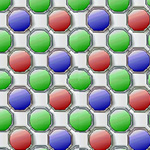| Main page Graphics Photography Music & Audio Audio Plugins Video Tools Web Design Documents Space Astro Amiga Funny Surreal Links & Contact |
Fuji S2pro and S5pro RAW Format Sharpness TestGeneral sharpness tests First I want to notice that this test is only relevant for the Fuji S2/S3/S5pro cameras.
For other brands of cameras, the results will typically be completely different, and most of the software described here works very well for those other cameras. This is a very Fuji-specific issue. Different parts of this test are not the same age, and there have been improvements to both Adobe's RAW loader and dcraw as far as I can tell.
First I want to notice that this test is only relevant for the Fuji S2/S3/S5pro cameras.
For other brands of cameras, the results will typically be completely different, and most of the software described here works very well for those other cameras. This is a very Fuji-specific issue. Different parts of this test are not the same age, and there have been improvements to both Adobe's RAW loader and dcraw as far as I can tell.
The problem is that most camera raw loaders mess up royally when they try to decode the Fuji S2pro, S3pro and S5pro images. This is because Fuji's SuperCCD is not a normal bayer pattern. It is uncertain whether the sensors are really just "rotated 45 degrees" as commonly belived. The sensor array of the S2 is said to have the layout displayed to the right. The S3 and S5 use variations on this theme. I will now demonstrate the image quality with focus on sharpness using different methods of converting the image into jpeg images. So let's get on with the test... RawConverter LE (S2 Pro) Adobe RAW 3.4 (S2 Pro) Obviously the unusual sub pixel positioning of the S2pro is causing Adobe some trouble making lines vary in thickness. More moir is also visible. Fuji HyperUtility 3 (S3 Pro) Adobe Camera Raw 4.6 (S3 Pro) dcraw 9.05 (S3 Pro) dcraw 9.05 using fujiturn.c (S3 Pro) This time I used later versions of the various software with the Fuji S3 Pro and a Nikon 85mm F1.4 stopped down to F8. All images come from the same raw file. For the last dcraw test, I used the alternative fujiturn.c code to rotate the image. We no longer have quite as clear a winner as before. My personal impression is that Fuji's own software wins on over-all performance, being fairly good at extrapolating both sharpness and color precision, and it's the only software that understands both S and R pixels of this camera (giving a 4x boost in dynamic range over cameras of the same age and price.) Adobe's raw loader wins on usability and adjustment features as well as good integration with Photoshop. Sharpness is acceptable but has to be helped with sharpness more than Fuji's software to reach the same clarity. dcraw wins on scriptability, being free, and giving some nice options to bypass various interpolations. It also has excellent noise reduction. Unfortunately it doesn't handle moiré very well. ISO 1600 testsThe difference between jpeg and the different raw formats are especially pronounced when putting both resolution and iso to the highest levels. For this test i have pushed the camera to the pseudo 12-megapixel mode at iso 1600. This yelds an image of 4256 x 2848 pixels.Camera JPEG (1:1 pixel cut-out)All settings set to STD and sunshine white balance.  Fuji RAW Converter EX (1:1 pixel cut-out)All settings set to follow camera settings and sunshine white balance.  Adobe RAW Converter 3.7 (1:1 pixel cut-out)The resolution is lower than expected, and there is more noise despite trying hard to find the most noiseless and yet sharp setting. Adobe RAW is generally good, just don't use it on a SuperCCD camera.  DCRaw 8.77The resolution is again lower than expected, and the output is rotated 45 degrees internally in the algorithms used by dcraw. The output is only 71% of what it should be. Just like Adobe, dcraw does not seem to fully understand how the subpixels in the SuperCCD are arranged. The wavelet based noise reduction in dcraw is quite excellent though.  The entire picture i used can be seen here scaled down a bit to 1280x857 pixels for faster download. As you can see this old camera (from Jan. 2002) still performs quite decently at iso 1600. Fuji S5 Pro: Same issueI actually wanted to test a newer version of Adobe's RAW loader, but they stopped supporting Windows 2000, so the first few tests are performed with Adobe RAW 3.7. Further down this article there are tests of more recent versions, not that this makes a big difference. Generally for these tests the colors look nice on right-hand examples (Adobe), but resolution is much poorer than Fuji's software in all test shots.
Website by Joachim Michaelis
|
||||||||||||||||||||||||||||||||










